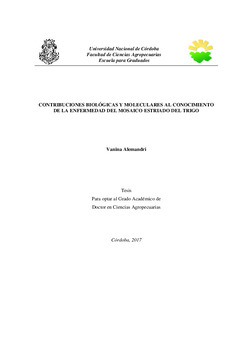| dc.contributor | López Lambertini, Paola María | |
| dc.contributor.advisor | Truol, Graciela A. | |
| dc.contributor.author | Alemandri, Vanina M. | |
| dc.date.accessioned | 2018-11-09T14:07:59Z | |
| dc.date.available | 2018-11-09T14:07:59Z | |
| dc.date.issued | 2017 | |
| dc.identifier.uri | http://hdl.handle.net/11086/6821 | |
| dc.description | Tesis (Doctor en Ciencias Agropecuarias) -- UNC- Facultad de Ciencias Agropecuarias, 2017 | es |
| dc.description.abstract | El virus del mosaico estriado del trigo (Wheat streak mosaic virus, WSMV), transmitido por el ácaro Aceria tosichella, es considerado plaga no cuarentenaria reglamentada en Argentina. El objetivo general de esta Tesis fue caracterizar los componentes y su diversidad del patosistema WSMV-A. tosichella-trigo necesarios para seleccionar estrategias efectivas de manejo de la enfermedad. Se desarrolló una estrategia para la amplificación del genoma completo de WSMV y su posterior pirosecuenciación. Se obtuvo la secuencia completa de 13 aislamientos provenientes de Triticum aestivum, Avena fatua, Digitaria sanguinalis y de diferentes regiones trigueras. Las estrechas relaciones filogenéticas encontradas entre los aislados argentinos de WSMV, los australianos y los de la región del Pacífico noroeste de Estados Unidos (APNW) sugieren que la presencia del WSMV en nuestro país se podría haber originado a partir de una única introducción desde la región APNW. Además, se realizó la caracterización de la población intra-hospedante mediante la reconstrucción de haplotipos y la búsqueda de polimorfismos de simple nucleótido de los 13 aislamientos. Tres aislamientos se distinguieron por su mayor diversidad y distribución de mutaciones a lo largo de su genoma, y los restantes fueron menos diversos. Se determinó la presencia de Triticum mosaic virus completando el complejo WSMV-HPWMoV-TriMV en Argentina. Se detectó solamente el linaje WCM2 de A. tosichella, considerado el más invasivo. Se encontraron distintas especies de Eriophyidae en cerelaes y malezas aledañas a trigo. Aculodes stipacolus proveniente de Stipa sp. se describió por primera vez para América del Sur. Se identificó Abacarus hystrix constituyendo una alerta por su capacidad transmisora de virus que no se encuentran en el país. También, se realizó la evaluación del comportamiento de cultivares de trigos frente a dos complejos WSMV-A. tosichella de Argentina. Los cultivares presentaron diferentes niveles de tolerancia dependiendo de la virulencia del asilamiento de WSMV en invernáculo y a campo. Estos resultados contribuyen al establecimiento de estrategias de manejo efectivas para el patosistema WSMV-A. tosichella-trigo en Argentina. | es |
| dc.description.abstract | Wheat streak mosaic virus (WSMV) is transmitted by the mite Aceria tosichella and is considered a regulated non-quarantine pest in Argentina. The general aim of this thesis work was to characterize the components and their diversity of the WSMV-A tosichella-wheat pathosystem required to select effective strategies for managing wheat streak mosaic disease. A strategy for the amplification of the whole WSMV genome and further pyrosequencing was developed. The whole sequence of 13 isolates from Triticum aestivum, Avena fatua, Digitarias anguinalis and from different wheat producing areas was obtained. The close phylogenetic relationships found among the WSMV isolates from Argentina, Australia and the American Pacific northwestern (APNW) suggest that the presence of WSMV in Argentina might have originated from a single introduction from the APNW region. Moreover, the intra-host population was characterized by reconstructing haplotypes and searching for single-nucleotide polymorphisms of the 13 isolates. Three isolates were distinguished for their greater diversity and distribution of mutations along the genome, and the rest was less diverse. The presence of Triticum mosaic virus was detected as completing the WSMV-HPWMoV-TriMV complex in Argentina. Only the WCM2 lineage of A. tosichella, the most invasive one, was detected. Different species of Eriophyidae were found in cereals and weeds adjacent to wheat. Aculodes stipacolus from Stipasp. is described for the first time for South America. Likewise, Abacarus hystrix was identified, which poses a threat due to its capacity of transmitting viruses that are not present in the country. Moreover, the behavior of wheat cultivars against two WSMV-A. tosichella complexes from Argentina was evaluated. The cultivars exhibited different levels of tolerance, depending on the viral isolate virulence in greenhouse and in the field. These results contribute to the development of effective management strategies for the WSMV-A. tosichella-wheat pathosystem in Argentina. | en |
| dc.format.extent | 158 h. : ilustración, tablas, gráficos color | es |
| dc.language.iso | spa | es |
| dc.rights | Attribution-NonCommercial-NoDerivatives 4.0 Internacional | * |
| dc.rights.uri | http://creativecommons.org/licenses/by-nc-nd/4.0/ | * |
| dc.subject | Trigo | es |
| dc.subject | Enfermedades de las plantas | es |
| dc.subject | Virus del mosaico | es |
| dc.subject | Control de enfermedades | es |
| dc.title | Contribuciones biológicas y moleculares al conocimiento de la enfermedad del mosaico estriado del trigo | es |
| dc.type | doctoralThesis | es |





